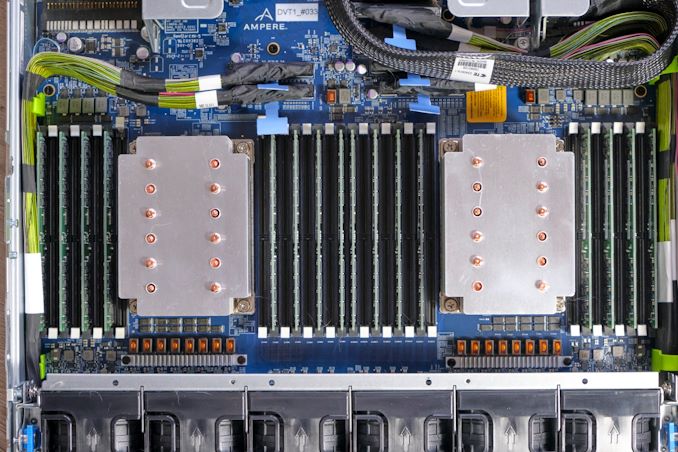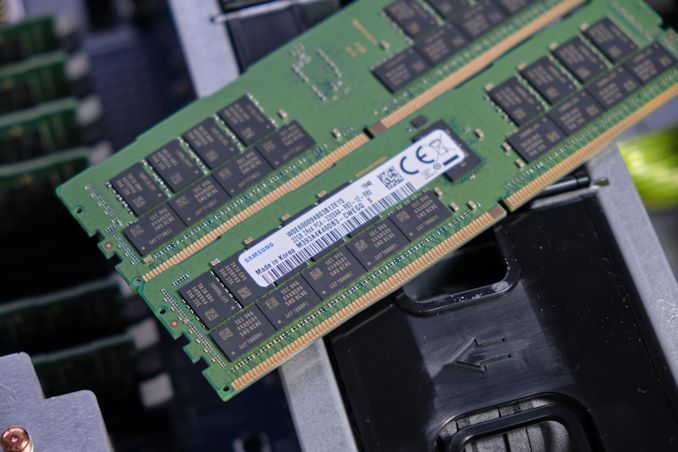The Ampere Altra Review: 2x 80 Cores Arm Server Performance Monster
by Andrei Frumusanu on December 18, 2020 6:00 AM EST- Posted in
- Servers
- Neoverse N1
- Ampere
- Altra
Test Bed and Setup - Compiler Options
For the rest of our performance testing, we’re disclosing the details of the various test setups:
Ampere "Mount Jade" - Dual Altra Q80-33
Obviously, for the Ampere Altra system we’re using the provided Mount Jade server as configured by Ampere.
The system features 2 Altra Q80-33 processors within the Mount Jade DVT motherboard from Ampere.
In terms of memory, we’re using the bundled 16 DIMMs of 32GB of Samsung DDR4-3200 for a total of 512GB, 256GB per socket.
| CPU | 2x Ampere Altra Q80-33 (3.3 GHz, 80c, 32 MB L3, 250W) |
| RAM | 512 GB (16x32 GB) Samsung DDR4-3200 |
| Internal Disks | Samsung MZ-QLB960NE 960GB Samsung MZ-1LB960NE 960GB |
| Motherboard | Mount Jade DVT Reference Motherboard |
| PSU | 2000W (94%) |
The system came preinstalled with CentOS 8 and we continued usage of that OS. It’s to be noted that the server is naturally Arm SBSA compatible and thus you can run any kind of Linux distribution on it.
Ampere makes special note of Oracle’s active support of their variant of Oracle Linux for Altra, which makes sense given that Oracle a few months ago announced adoption of Altra systems for their own cloud-based offerings.
The only other note to make of the system is that the OS is running with 64KB pages rather than the usual 4KB pages – this either can be seen as a testing discrepancy or an advantage on the part of the Arm system given that the next page size step for x86 systems is 2MB – which isn’t feasible for general use-case testing and something deployments would have to decide to explicitly enable.
The system has all relevant security mitigations activated, including SSBS (Speculative Store Bypass Safe) against Spectre variants.
AMD - Dual EPYC 7742
For our AMD system, unfortunately we had hit some issues with our Daytona reference server motherboard, and moved over to a test-bench setup on a SuperMicro H11DSI0.
We’re also equipping the system with 256GB per socket of 8-channel/DIMM DDR4-3200 memory, matching the Altra system.
| CPU | 2x AMD EPYC 7742 (2.25-3.4 GHz, 64c, 256 MB L3, 225W) |
| RAM | 512 GB (16x32 GB) Micron DDR4-3200 |
| Internal Disks | OCZ Vector 512GB |
| Motherboard | SuperMicro H11DSI0 |
| PSU | EVGA 1600 T2 (1600W) |
As an operating system we’re using Ubuntu 20.10 with no further optimisations. In terms of BIOS settings we’re using complete defaults, including retaining the default 225W TDP of the EPYC 7742’s, as well as leaving further CPU configurables to auto, except of NPS settings where it’s we explicitly state the configuration in the results.
The system has all relevant security mitigations activated against speculative store bypass and Spectre variants.
Intel - Dual Xeon Platinum 8280
For the Intel system we’re also using a test-bench setup with the same SSD and OS image actually – we didn’t have enough RAM to run both systems concurrently.
Because the Xeons only have 6-channel memory, their maximum capacity is limited to 384GB of the same Micron memory, running at a default 2933MHz to remain in-spec with the processor’s capabilities.
| CPU | 2x Intel Xeon Platinum 8280 (2.7-4.0 GHz, 28c, 38.5MB L3, 205W) |
| RAM | 384 GB (12x32 GB) Micron DDR4-3200 (Running at 2933MHz) |
| Internal Disks | OCZ Vector 512GB |
| Motherboard | ASRock EP2C621D12 WS |
| PSU | EVGA 1600 T2 (1600W) |
The Xeon system was similarly run on BIOS defaults on an ASRock EP2C621D12 WS with the latest firmware available.
The system has all relevant security mitigations activated against the various vulnerabilities.
Compiler Setup
For compiled tests, we’re using the release version of GCC 10.2. The toolchain was compiled from scratch on both the x86 systems as well as the Altra system. We’re using shared binaries with the system’s libc libraries.












148 Comments
View All Comments
mode_13h - Monday, December 21, 2020 - link
I agree that people should do a sanity-check on their numbers.Spunjji - Monday, December 21, 2020 - link
"This thing is quite big."Package size is not die size.
If Nvidia can pump out dies more than twice the area on an inferior process and still get some perfect dies, I suspect they'll have no issues whatsoever with yield on TSMC 7nm at this stage - especially with the ability to sell lower-core-count variants.
Samus - Sunday, December 20, 2020 - link
Die harvested models with less cores sell for only 5-10% less. So I'm not sure if that means yields are really good, or really bad. Apparently they seem to be pushing the 80 core models pretty hard since so many are being offered.Then again, it depends what we define as yield quality? Defects seem to be low, but binning could be another issue as only two models seem to hit 3.3GHz and at incredibly high power budgets.
Spunjji - Monday, December 21, 2020 - link
3.3Ghz is about where that architecture tops out - I'm not sure that tells us much about yield. To me, the pricing seems to indicate that they aren't expecting to have to shift a ton of the lower-core-count die-harvested models.damianrobertjones - Friday, December 18, 2020 - link
Assuming that Intel just wants to milk customers forever, just like nVidia/phone oems do, they should quickly bridge the performance gap. They'll just have to stop being lazy and actually provide us with more than a drip fed speed increase.fishingbait - Friday, December 18, 2020 - link
An Apple guy I see. Remember that up until a couple of months ago Apple was charging you $1000 for a laptop with a dual core 1.1GHz chip.The "phone OEMs" finally have a core that can somewhat compete with Apple's Firestorm. It will take them a couple iterations to perfect it but they are on the right path. As for Intel, another story entirely. The latest word is that their 10nm process isn't going to well and they have hit yet another delay for 7nm. They may hit up Samsung's foundries just to get a product out (due to TSMC not having any capacity until December 21). So while their issues are far more significant than those for Android phones, it isn't due to their lazily milking customers. They have real tech issues to deal with, issues of the sort that Apple and AMD don't have to worry about because they lack the capability and expertise required to make their own chips.
mode_13h - Sunday, December 20, 2020 - link
> because they lack the hubris to think they should try to make their own chips.Fixed that for you.
Spunjji - Monday, December 21, 2020 - link
"So while their issues are far more significant than those for Android phones, it isn't due to their lazily milking customers."Correct, their technical issues are entirely separate from their strategy of lazily milking customers.
Ridlo - Friday, December 18, 2020 - link
While no Blender test is indeed a bummer, did you guys tried testing with other ray tracing application (LuxMark, C-Ray, Povray, etc.)?Andrei Frumusanu - Friday, December 18, 2020 - link
I didn't have a standalone test, but Povray is part of SPEC.